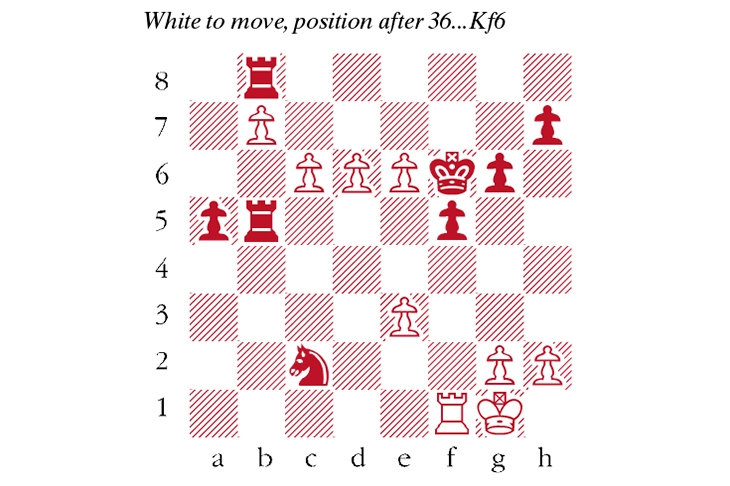The German word for pawn, ‘bauer’, can also be translated as peasant, or farmer. There are many spectacular games in which the pawns pick up their pitchforks and overrun the landed gentry. A historic example, played in 1834, is the game McDonnell–de La Bourdonnais, in which the Frenchman playing Black advanced his pawns to d2, e2 and f2, overwhelming White’s rook and queen. A modern example is the game Saric–Suleymanli, which I wrote about in December last year. Aydin Suleymanli, just 14 years old from Azerbaijan, acquitted himself well but eventually succumbed to the advancing horde.
Much less gets written about failed uprisings, but in this week’s game Suleymanli found himself yet again facing down an angry mob. Events hung in the balance, but on this occasion the mob was quashed, amid spectacular complications.
The Aeroflot Open is a tremendously strong tournament played annually in Moscow, and Suleymanli’s performance was the sensation of the event. He took first place on tiebreak with an unbeaten 6.5/9, and earns an invitation to his first super-tournament in Dortmund later this year.
Vasif Durarbayli–Aydin Suleymanli
Aeroflot Open, Moscow, February 2020
1 e4 c6 2 d4 d5 3 e5 Bf5 4 Nf3 e6 5 Be2 c5 6 Be3 Qb6 7 Nc3 Nc6 8 Na4 Qa5+ 9 c3 c4 10 Nh4 b5 11 Nxf5 exf5 12 Nc5 Bxc5 13 dxc5 Nge7 14 b4 Qa3 15 Qc2 d4 A good breakthrough, though the game soon becomes wildly complex. 16 cxd4 Qxb4+ 17 Qd2 a5 17… f4! was best played immediately. 18 a4! An excellent move, breaking down Black’s queenside pawn mass. 18 …f4 This wins a piece, but now White’s own pawns become a force to be reckoned with. 19 axb5 c3 20 Qd3 fxe3 21 fxe3 Qb2 22 O-O Nb4 23 Qe4 O-O 24 Bc4 c2 25 Rac1 Rad8 Presumably Black felt it necessary to restrain d4-d5-d6, but in fact it was possible to press on, as 25… a4 26 d5 Ng6! 27 d6 Nxe5 keeps everything under control. 26 Bd3 g6 27 b6 Ned5 28 Bc4 28 Bxc2 suggests itself, though Black wins material with Nc3 29 Qf3 Nba2! (not 29… Nxc2 30. Qf2!) But the madness continues: 30 Bd3! Nxc1 31 Bc4 N1e2+ 32 Kh1 White threatens Bc4xf7+ followed by Qf3-f6+, so the only winning try is 32…Ne4! 33. Qxe2 Qc3 and the game rumbles on. 28… Qc3 29 Bxd5 Rxd5 30 b7 Rb8 31 e6 A very plausible push, but the extraordinary 31 g4!! was best. The point is that after Rxb7 32 e6 Kf8, (not 32… f5 33 e7!) 33 exf7 Rxf7 34 Rxf7+ Kxf7 35 Rf1+ the f5 square is under control. Now Rf5 36 gxf5 c1=Q 37 fxg6+ leads to perpetual check. 31… f5 32 Rxc2 Qxc2 33 Qxc2 Nxc2 34 c6 Rb5! 35 d5 Kg7 35… Nxe3 is tempting, but after 36 d6 R5xb7 37 Re1!! saves White, e.g. Rb2 38 e7 Kf7 39 c7 Ke8 40 cxb8=Q+ Rxb8 41 Rxe3 Kd7 with a draw, as Black’s a-pawn will soon deflect the white rook. 36 d6 Kf6 (see diagram) 36… Nb4 was best: 37 c7 R5xb7 38 cxb8=Q Rxb8 39 e4 Kf6 40 exf5 gxf5 41 e7 Ke6 42 Rxf5 Nc6 43 Rf8 Kd7 Black is just in time, and probably winning. 37 d7? The wrong pawn. 37 e7! was the way to do it. R5xb7 38 cxb7 Ke6 39 Rc1 Kxd6 40 Rxc2 Kxe7 41 Ra2 Rxb7 42 Rxa5 with a draw. 37… Rc5! At last the pawns are brought to heel. 38 Rd1 Rd8 39 e4 39 Rb1 Nb4! successfully restrains the white rook. 39… Ke7 40 exf5 gxf5 41 Rd5 and White resigns before seeing 41…Rxc6.






Comments